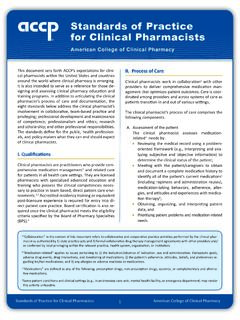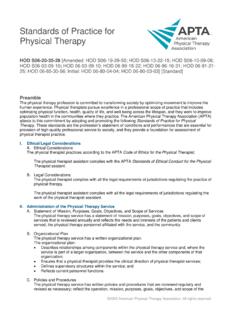Transcription of IMPROVING HEALTH WORKER PRODUCTIVITY AND …
1 IMPROVING HEALTH WORKER PRODUCTIVITY AND PERFORMANCE IN THE CONTEXT OF UNIVERSAL HEALTH COVERAGE: THE ROLES OF STANDARDS, QUALITY IMPROVEMENT, AND REGULATION TECHNICAL WORKING GROUP (TWG) #7 This paper serves as a background report to inform the Global Strategy for Human Resources for HEALTH . The development of this paper has been coordinated through a thematic working group (TWG), comprising of 2 co-chairs and a group of experts drawn from various Global HEALTH Workforce Alliance (GHWA) constituencies, operating under the oversight of the GHWA Board working group. The views expressed in the paper, do not necessarily reflect the official position of GHWA. All reasonable precautions have been taken by the co-chairs to verify the information presented in the papers. - DRAFT FOR CONSULTATION - Not to be quoted or referenced without prior permission from the authors.
2 Not for wider distribution. Final Draft August 29, 2014 1 IMPROVING HEALTH WORKER PRODUCTIVITY AND PERFORMANCE IN THE CONTEXT OF UNIVERSAL HEALTH COVERAGE: THE ROLES OF STANDARDS, QUALITY IMPROVEMENT, AND REGULATION FINAL DRAFT BY TECHNICAL WORKING GROUP #7 CO-CHAIRS: Frances Day-Stirk President, International Confederation of Midwives (ICM) The Hague, Netherlands M. Rashad Massoud, MD, MPH, FACP Director, USAID Applying Science to Strengthen and Improve Systems Project, Senior Vice President, Quality & Performance Institute, University Research Co. LLC. - Center for Human Services Bethesda, Maryland, USA Final Draft August 29, 2014 2 I N T RODUC TI ON The Global HEALTH Workforce Alliance (GHWA) has coordinated a global consultation, with the objective to inform a future strategy on human resources for HEALTH (HRH) that will be relevant to the post-2015 development agenda (2015-2030) for all countries at all stages of socio-economic development.
3 The consultation builds on earlier work on the HRH implications of Universal HEALTH Coverage (UHC), with additional analyses of: future scenarios in the period 2015-2030; multi-sectoral government activities, such as the International Labor Organization s work with its Member States on strengthening social protection systems, and; opportunities arising from the anticipated economic, demographic, and epidemiologic transitions in many low- and middle-income countries. The consultation includes eight themesi that can contribute to the overall development of a forward-looking strategy. The objective of this paper by Working Group #7 is to examine the evidence and provide recommendations on the roles of standards, quality improvement, and regulation for IMPROVING HEALTH WORKER PRODUCTIVITY and performance at all levels of the HEALTH system (see Table 1 for working definitions used in the paper).
4 We present a framework based on the review of selected evidence of factors promoting and impeding productive and performance (Figure 1). Table 1: Working Definitions Human resources management Interventions that aim for effective utilization of human resources in an organization1 Incentives All the rewards and punishments that providers face as a consequence of the organizations in which they work, the institutions under which they operate and the specific interventions they provide2 Pay for performance The transfer for money or material goods conditional on taking a measurable HEALTH related action or achieving a predetermined performance target3 Performance Performance of HEALTH workers includes the quality of their work, the technical skills they use, the care they deliver, and the impact of their work on HEALTH i Working group themes: 1)The drivers of change in HEALTH labor markets.
5 2) The role of transformative education; 3)Data and measurement of HRH availability, accessibility, acceptability and quality; 4) Accountability and alignment for post-2015: the roles and responsibilities of state and non-state actors; 5) Leadership, governance and policy alignment in public/private HEALTH systems; 6) The drivers of change in Fragile States; 7) IMPROVING PRODUCTIVITY and performance: the roles of regulation, professional associations and standards; and 8) Building on human capability beyond the HEALTH sector. Final Draft August 29, 2014 3 PRODUCTIVITY PRODUCTIVITY of HEALTH workers is determined by the setting in which they work, their level of motivation, work organization, management capacity, the division of labor and other resources ( , equipment, drugs, examination rooms, and other characteristics of the setting) Quality Quality of care is the function of the healthcare delivery system to deliver safe, effective, and patient-centered care in an efficient, timely and equitable manner.
6 The Institute of Medicine (IoM) defines quality of care as the degree to which HEALTH services for individuals and populations increase the likelihood of desired HEALTH outcomes and are consistent with current professional knowledge. 6 Recognition systems A systematic approach or strategy to acknowledge, reward, and motivate the performance of HEALTH workers to provide quality HEALTH services through appropriate financial and non-financial Regulation All those legitimate, appropriate and sustained means where order identify, consistency, control and accountability are brought to HEALTH systems through legally enforced and/or voluntary Standards Explicit statements of expected quality in the performance of a healthcare activity , how a particular healthcare activity will be performed in order to produce the desired results. May take the form of procedures, clinical practice guidelines, treatment protocols, critical paths, algorithms, standard operating procedures, or statements of expected healthcare B AC KG ROUN D IMPROVING HEALTH workers performance and PRODUCTIVITY is vital to IMPROVING HEALTH care delivery, the Millennium Development Goals, and commitments, policies, and actions beyond 2015.
7 The evolving momentum for Universal HEALTH Coverage offers an important opportunity to look at HRH challenges in the context of During the last decade, numerous intergovernmental resolutions as well as action plans have highlighted the importance of HRH However, policy makers and program planers still struggle to determine the correct set of actions to improve WORKER performance and PRODUCTIVITY . Critical human resources shortages, particularly in low-resource settings, require that we not only develop long-term strategies for increased production and retention of HEALTH workers 17 but more importantly that we strengthen the PRODUCTIVITY and performance of the workforce we have so as to get the best possible results and the highest impact with existing resources. HEALTH WORKER performance barriers such as unclear roles and expectations, unclear guidelines, poor processes of work, inappropriate skills mix within the work setting, competency gaps, lack of feedback, difficult work environments and unsuitable incentives mean that even where there are no critical workforce shortages, HEALTH workers may still fail to provide quality care.
8 While substantive evidence of the effectiveness of different types of interventions to improve WORKER performance and PRODUCTIVITY is still limited, salient features are emerging from existing studies and country experiences that can help inform a strategy for optimizing the performance and PRODUCTIVITY of HEALTH workers and HEALTH WORKER Final Draft August 29, 2014 4 MET HODS This paper was developed by a group of experts comprised of representatives of professional associations, non-governmental organizations, multi-lateral organizations and bilateral organizations representing all regions of the world. The paper and its recommendations were informed by a targeted desk study of published and grey material. In addition, detailed feedback from a group of expert reviewers on the roles of quality improvement, regulation in HRH, and standards in addressing HEALTH WORKER performance and PRODUCTIVITY was obtained on drafts of the paper.
9 An adaptation of the Dieleman et al. framework formed the focus and direction of the paper (Figure 1).20 IMPROVING HEALTH WORKER PERFORMANCE AND PRODUCTIVITY FRAM EWORK OVERVIE W Figure 1 highlights that the determinants of HEALTH workers performance and PRODUCTIVITY are rooted in factors related to: 1) the macro, or overall HEALTH systems, socio-economic/labor market, and political level; 2) the micro level, such as the workplace itself or the communities in which HEALTH workers live; and 3) the individual characteristics of HEALTH workers HRH interventions such as standards of HEALTH care, quality improvement and regulation (inputs and processes) work in a dynamic relationship with each other to improve HEALTH WORKER performance and PRODUCTIVITY : Standards should codify the evidence based interventions that should be incorporated into practice and the performance expectations in the delivery or implementation of quality of HEALTH services.
10 Standards drive the improvement efforts needed to ensure their reliable implementation in everyday practice, yet at the same time the experience of IMPROVING care can shed light on the realities of how to implement the statndards and can consequently inform the revisions of these standards. Through regulatory approaches, governments can establish expectations for the competence of healthcare providers and the standards of the services. Other inputs and processes such as strong human resource management and recognition systems to support quality services and ongoing monitoring and evaluation of care processes are also needed to improve the availability, responsiveness, and competence of the HEALTH workforce. As will be described in the following sections, there is no clear linear relationship between inputs, processes and outcomes, and between outcomes and effects.
















